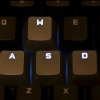Correlation between frame rate and refresh rate
The computer pushes frames to the monitor's buffer based on the frame rate.
If the frame rate is higher than the refresh rate then the next time the monitor updates the screen there is a higher probability of a newer frame having been pushed to the buffer, aka reducing the delay from the time the frame was produced to the time it is shown on screen.
This is because the monitor and computer aren't synced in any way, so it's not possible for a computer to render a frame and push it to the monitor just before the monitor refreshes.
Of course the computer isn't pushing out frames one at a time, it progressively scans every frame and sends it to the monitor, so if the monitor refreshes when part of a frame is being written to the buffer it will show part of the old frame and part of the new frame, and this is screen tearing.
If you want the most response "feel" when gaming, your fps should be as high as possible regardless of the monitor's refresh rate.
Even though screen tearing may occur, that means part of the image on the screen is a newer frame, which is helpful in fast paced fps games.










.thumb.jpg.271b3e6811b76c1a6c28065117ae6c81.jpg)








Create an account or sign in to comment
You need to be a member in order to leave a comment
Create an account
Sign up for a new account in our community. It's easy!
Register a new accountSign in
Already have an account? Sign in here.
Sign In Now